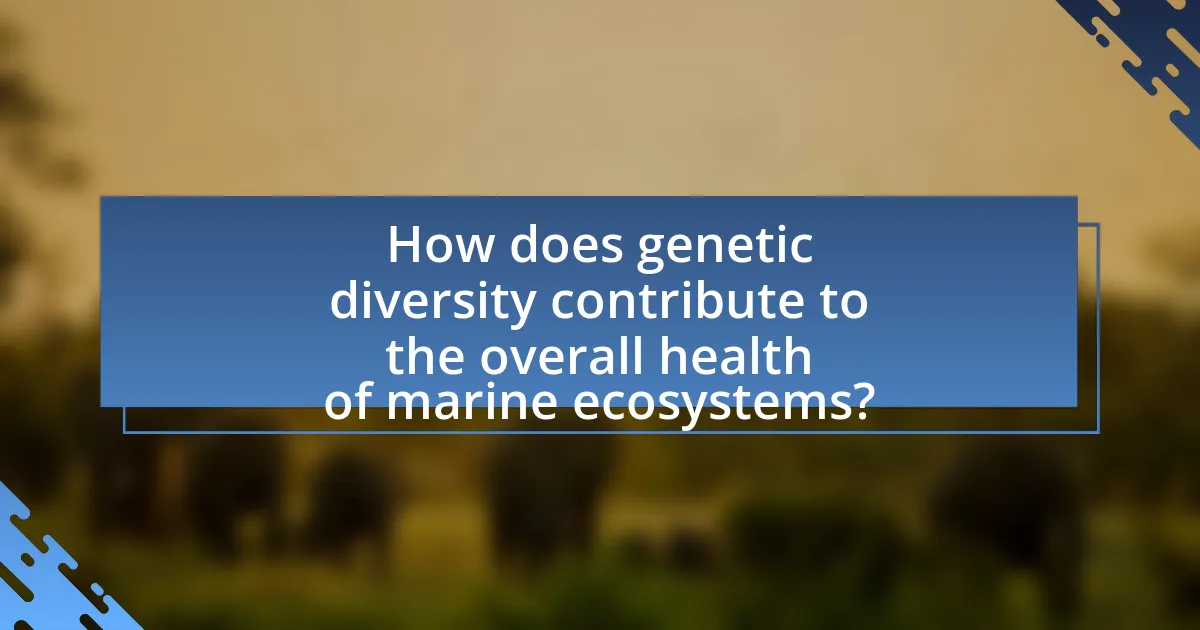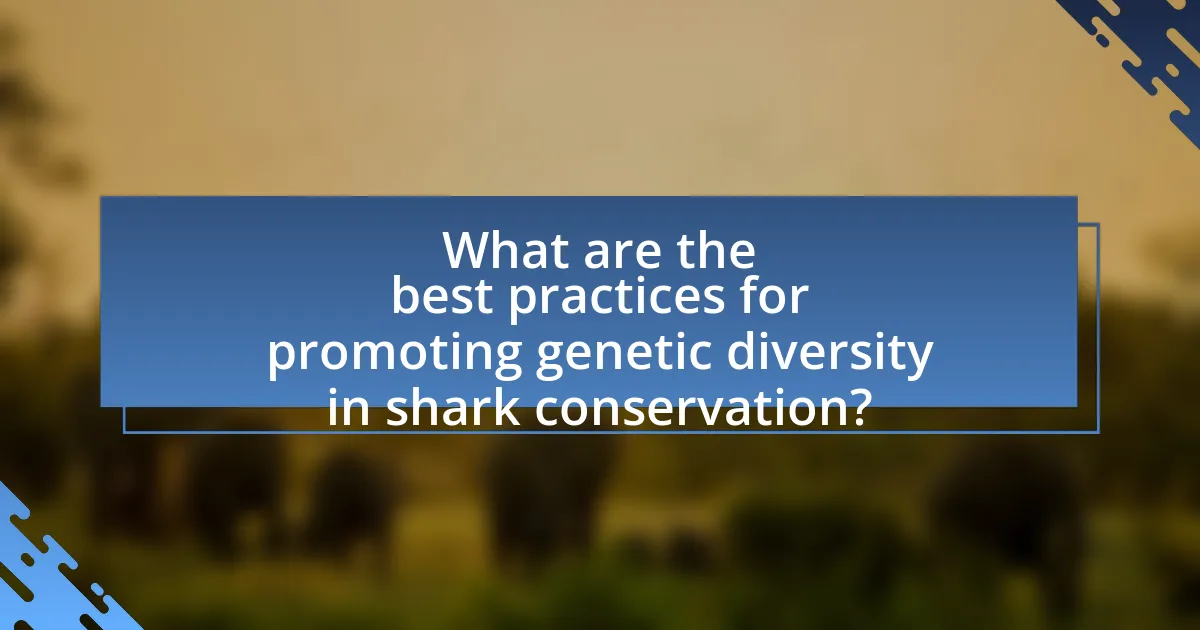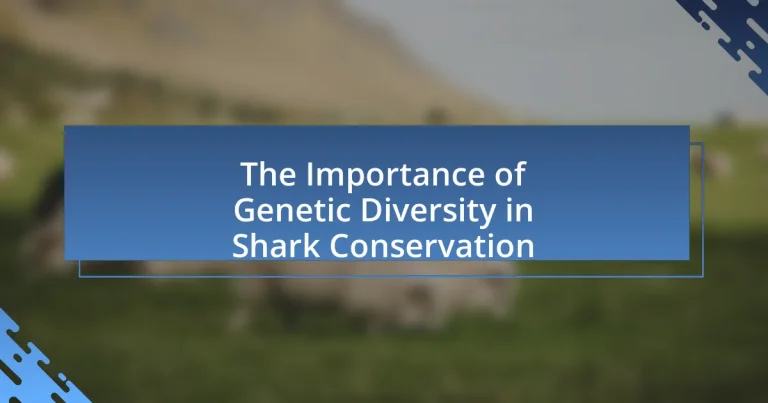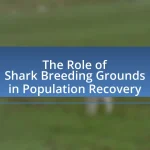The main entity of the article is genetic diversity in shark conservation. The article emphasizes the critical role of genetic diversity in enhancing the resilience of shark populations to environmental changes, diseases, and overfishing. It discusses how high genetic variability improves adaptability and reproductive success, contributing to the overall health of marine ecosystems. The article also outlines current threats to genetic diversity, including overfishing, habitat loss, and climate change, and highlights effective conservation strategies such as marine protected areas and sustainable fishing practices. Additionally, it addresses the importance of public awareness and individual actions in supporting shark conservation efforts.

What is the Importance of Genetic Diversity in Shark Conservation?
Genetic diversity is crucial for shark conservation as it enhances the resilience of shark populations to environmental changes and diseases. High genetic diversity allows for a greater range of traits within a population, which can improve adaptability to changing habitats and climate conditions. For instance, studies have shown that populations with higher genetic variation are more likely to survive and recover from overfishing and habitat loss, as they can better cope with stressors. Additionally, genetic diversity contributes to the overall health of marine ecosystems, as sharks play a vital role as apex predators. Maintaining genetic diversity is essential for ensuring the long-term survival of shark species and the stability of marine environments.
Why is genetic diversity crucial for shark populations?
Genetic diversity is crucial for shark populations because it enhances their ability to adapt to changing environments and resist diseases. High genetic variability allows sharks to survive in diverse habitats and cope with stressors such as climate change, overfishing, and pollution. For instance, studies have shown that populations with greater genetic diversity exhibit improved resilience to environmental changes and have higher reproductive success. This adaptability is vital for maintaining healthy shark populations, which play a key role in marine ecosystems as apex predators.
How does genetic diversity affect the resilience of shark species?
Genetic diversity enhances the resilience of shark species by increasing their ability to adapt to environmental changes and resist diseases. Higher genetic variation allows for a broader range of traits within a population, which can improve survival rates under stressors such as climate change, habitat loss, and overfishing. For instance, studies have shown that populations with greater genetic diversity are more likely to recover from population declines and maintain stable reproductive rates, as evidenced by research conducted on the blacktip reef shark, which demonstrated that genetic diversity correlates with reproductive success and population stability.
What role does genetic diversity play in adaptation to environmental changes?
Genetic diversity is crucial for adaptation to environmental changes as it enhances the ability of populations to respond to selective pressures. This diversity provides a wider range of traits that can be beneficial in changing conditions, such as climate shifts or habitat alterations. For instance, studies have shown that populations with higher genetic variability are more resilient to diseases and environmental stressors, which is vital for survival. In sharks, genetic diversity allows for variations in traits such as size, reproductive rates, and behavior, enabling them to adapt to changing oceanic environments. Research indicates that reduced genetic diversity in shark populations can lead to decreased adaptability, making them more vulnerable to extinction in the face of rapid environmental changes.
What are the current threats to genetic diversity in sharks?
Current threats to genetic diversity in sharks include overfishing, habitat loss, and climate change. Overfishing has led to significant population declines, reducing the genetic pool and increasing inbreeding risks. Habitat loss, particularly due to coastal development and pollution, disrupts breeding grounds and migratory routes, further threatening genetic diversity. Climate change affects ocean temperatures and acidification, which can alter shark distribution and reproductive success, compounding the risks to their genetic variability. These factors collectively undermine the resilience of shark populations, making them more vulnerable to extinction.
How do overfishing and habitat loss impact genetic diversity?
Overfishing and habitat loss significantly reduce genetic diversity in shark populations. Overfishing leads to the removal of large numbers of individuals, which can result in a genetic bottleneck, reducing the overall genetic variation within the population. For example, studies have shown that overfished shark species, such as the hammerhead, exhibit lower genetic diversity compared to healthier populations. Habitat loss, such as the destruction of coral reefs and coastal ecosystems, further exacerbates this issue by isolating populations and limiting gene flow between them. This isolation can lead to inbreeding and a decrease in adaptive potential, making sharks more vulnerable to environmental changes and diseases.
What is the effect of climate change on shark genetic diversity?
Climate change negatively affects shark genetic diversity by altering their habitats and reproductive patterns. Increased ocean temperatures and acidification can lead to shifts in distribution, which may isolate populations and reduce gene flow. For instance, studies have shown that rising temperatures can impact the timing of breeding and the survival of young sharks, leading to decreased population resilience. Additionally, habitat degradation, such as coral reef loss, further threatens genetic diversity by limiting the available environments for various shark species to thrive and reproduce.

How does genetic diversity contribute to the overall health of marine ecosystems?
Genetic diversity is crucial for the overall health of marine ecosystems as it enhances resilience to environmental changes and diseases. Diverse genetic traits within species, such as sharks, allow populations to adapt to varying conditions, ensuring their survival and the stability of the ecosystem. For instance, studies have shown that populations with higher genetic diversity are better equipped to withstand stressors like climate change and pollution, which can lead to ecosystem degradation. Additionally, genetic diversity supports the functioning of food webs, as it promotes a variety of interactions among species, contributing to ecosystem productivity and stability.
What is the relationship between shark genetic diversity and ecosystem stability?
Shark genetic diversity is directly linked to ecosystem stability, as higher genetic variation within shark populations enhances their resilience to environmental changes and stressors. This genetic diversity allows sharks to adapt to varying conditions, such as climate change and habitat degradation, which in turn supports the overall health of marine ecosystems. For instance, studies have shown that diverse shark populations can better maintain their roles as apex predators, which are crucial for regulating prey populations and maintaining the balance of marine food webs. Consequently, the loss of genetic diversity in sharks can lead to decreased ecosystem stability, as it may result in population declines and disruptions in ecological interactions.
How do genetically diverse shark populations influence prey dynamics?
Genetically diverse shark populations enhance prey dynamics by promoting a range of hunting strategies and ecological roles. This diversity allows sharks to adapt to varying environmental conditions and prey availability, leading to more effective predation and resource utilization. For instance, studies have shown that diverse shark species can target different prey sizes and types, which helps maintain balanced marine ecosystems. Research indicates that areas with higher genetic diversity in shark populations experience greater stability in prey populations, as diverse predation pressures prevent any single prey species from becoming overly dominant.
What are the implications of losing genetic diversity for marine biodiversity?
Losing genetic diversity has significant implications for marine biodiversity, particularly in the context of species resilience and adaptability. Reduced genetic variation limits the ability of marine species to adapt to changing environmental conditions, such as climate change, pollution, and habitat loss. For example, studies have shown that populations with low genetic diversity are more susceptible to diseases and have lower reproductive success, which can lead to population declines and increased extinction risk. Furthermore, the loss of genetic diversity can disrupt ecosystem functions and services, as diverse genetic traits contribute to the stability and productivity of marine ecosystems. This is particularly critical for sharks, which play a vital role in maintaining the balance of marine food webs.
How can conservation efforts enhance genetic diversity in sharks?
Conservation efforts can enhance genetic diversity in sharks by implementing habitat protection, establishing marine protected areas, and promoting sustainable fishing practices. Habitat protection ensures that critical breeding and feeding grounds remain intact, allowing diverse shark populations to thrive and interbreed. Marine protected areas create safe environments where sharks can reproduce without the pressures of fishing, leading to increased population sizes and genetic mixing. Additionally, sustainable fishing practices reduce overfishing and bycatch, which can deplete specific genetic lineages, thereby preserving the overall genetic health of shark populations. Research indicates that areas with effective conservation measures show higher genetic diversity, as seen in studies of the blacktip reef shark populations in the Pacific, where protected regions exhibited greater genetic variation compared to fished areas.
What strategies are effective in preserving genetic diversity in shark populations?
Effective strategies for preserving genetic diversity in shark populations include the establishment of marine protected areas (MPAs), sustainable fishing practices, and genetic monitoring programs. Marine protected areas help to create safe habitats where sharks can reproduce and thrive, thereby maintaining their genetic diversity. Sustainable fishing practices, such as catch limits and gear restrictions, reduce overfishing and allow for the recovery of shark populations, which is crucial for genetic variability. Genetic monitoring programs track the genetic health of shark populations, enabling conservationists to identify and address declines in genetic diversity. These strategies are supported by research indicating that MPAs can significantly enhance the abundance and diversity of marine species, including sharks, while sustainable fishing practices have been shown to improve population resilience and genetic diversity over time.
How can marine protected areas support genetic diversity in sharks?
Marine protected areas (MPAs) can support genetic diversity in sharks by providing safe habitats that facilitate breeding and reduce human-induced stressors. These designated zones limit fishing and habitat destruction, allowing shark populations to recover and maintain genetic variation. Research indicates that MPAs can enhance genetic diversity by promoting the connectivity of shark populations, as individuals can migrate freely between protected areas, leading to increased gene flow. For instance, a study published in the journal “Conservation Biology” found that MPAs in the Caribbean significantly improved genetic diversity in local shark populations by allowing for natural breeding behaviors and reducing the impacts of overfishing.

What are the best practices for promoting genetic diversity in shark conservation?
The best practices for promoting genetic diversity in shark conservation include establishing marine protected areas (MPAs), implementing sustainable fishing practices, and conducting genetic monitoring. MPAs provide safe habitats that allow shark populations to thrive and interbreed, which enhances genetic diversity. Sustainable fishing practices, such as catch limits and gear restrictions, help prevent overfishing and maintain healthy population sizes, which is crucial for genetic variability. Genetic monitoring through techniques like DNA barcoding enables researchers to assess genetic diversity and identify population structures, informing conservation strategies. These practices are supported by studies indicating that increased genetic diversity enhances resilience to environmental changes and disease, ultimately contributing to the long-term survival of shark species.
How can stakeholders collaborate to enhance shark genetic diversity?
Stakeholders can collaborate to enhance shark genetic diversity by implementing coordinated conservation strategies, such as habitat protection, breeding programs, and genetic monitoring. Collaborative efforts among governments, NGOs, researchers, and local communities can lead to the establishment of marine protected areas that safeguard critical habitats, thereby promoting natural breeding and genetic exchange among shark populations. For instance, the establishment of the Great Barrier Reef Marine Park has shown that protected areas can significantly increase biodiversity and genetic diversity in marine species. Additionally, stakeholders can engage in genetic research to identify distinct populations and their genetic health, which can inform targeted conservation actions. Collaborative initiatives like the Shark Conservation Strategy by the International Union for Conservation of Nature emphasize the importance of data sharing and joint research efforts to monitor genetic diversity effectively.
What role do research and monitoring play in conservation efforts?
Research and monitoring are critical components of conservation efforts as they provide essential data for understanding species populations, ecosystems, and the effectiveness of conservation strategies. Specifically, in the context of shark conservation, research helps identify genetic diversity within shark populations, which is vital for their resilience and adaptability to environmental changes. For instance, studies have shown that higher genetic diversity in shark species correlates with better survival rates and reproductive success, making it a key factor in their long-term conservation. Monitoring, on the other hand, allows conservationists to track changes in shark populations and habitats over time, enabling timely interventions when threats are detected. This combination of research and monitoring ensures that conservation efforts are informed by accurate, up-to-date information, ultimately enhancing the effectiveness of strategies aimed at preserving shark species and their ecosystems.
How can public awareness campaigns contribute to shark conservation?
Public awareness campaigns can significantly contribute to shark conservation by educating the public about the ecological role of sharks and the threats they face. These campaigns raise awareness about the importance of genetic diversity in shark populations, which is crucial for their resilience and adaptability to environmental changes. For instance, studies indicate that diverse genetic pools enhance the survival rates of species, making them less vulnerable to diseases and climate change. By informing communities about sustainable practices and the impact of overfishing, public awareness campaigns can foster support for conservation initiatives, leading to policy changes and increased funding for research and protection efforts.
What practical steps can individuals take to support shark conservation?
Individuals can support shark conservation by advocating for sustainable seafood choices, reducing plastic use, and participating in local conservation efforts. By choosing seafood certified by organizations like the Marine Stewardship Council, individuals help reduce overfishing and promote sustainable practices that protect shark populations. Reducing plastic waste is crucial, as marine debris poses a significant threat to sharks and their habitats; studies show that over 1 million marine animals, including sharks, die each year due to plastic pollution. Additionally, engaging in local beach clean-ups and supporting marine protected areas can directly contribute to the preservation of shark habitats and biodiversity.
How can responsible consumer choices impact shark populations?
Responsible consumer choices can significantly impact shark populations by reducing demand for shark products, which in turn helps to decrease overfishing and habitat destruction. When consumers opt for sustainable seafood and avoid products like shark fin soup, they contribute to the preservation of shark species, many of which are threatened or endangered. For instance, the International Union for Conservation of Nature (IUCN) reports that over 30% of shark species are at risk of extinction due to unsustainable fishing practices. By choosing sustainably sourced seafood, consumers can support fisheries that prioritize the health of marine ecosystems, thereby promoting genetic diversity within shark populations, which is crucial for their resilience and adaptability.
What actions can local communities take to protect shark habitats?
Local communities can protect shark habitats by implementing sustainable fishing practices, establishing marine protected areas, and engaging in habitat restoration efforts. Sustainable fishing practices, such as catch limits and seasonal closures, help maintain shark populations and their ecosystems. Marine protected areas, which restrict human activities, provide safe havens for sharks to thrive and reproduce. Habitat restoration efforts, like coral reef rehabilitation, enhance the overall health of marine environments, benefiting sharks and other marine life. These actions are supported by studies indicating that well-managed marine reserves can lead to increased shark populations and biodiversity, highlighting the effectiveness of community involvement in conservation efforts.


